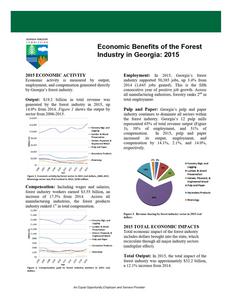Economic Benefits of the Forest Industry in Georgia: 2015
2015 ECONOMIC ACTIVITY Economic activity is measured by output, employment, and compensation generated directly by Georgia's forest industry.
Output: $19.2 billion in total revenue was generated by the forest industry in 2015, up 14.0% from 2014. Figure 1 shows the output by sector from 2006-2015.
Employment: In 2015, Georgia's forest industry supported 50,385 jobs, up 3.4% from 2014 (1,645 jobs gained). This is the fifth consecutive year of positive job growth. Across all manufacturing industries, forestry ranks 2nd in total employment.
Pulp and Paper: Georgia's pulp and paper industry continues to dominate all sectors within the forest industry. Georgia's 12 pulp mills represented 65% of total revenue output (Figure 3), 38% of employment, and 51% of compensation. In 2015, pulp and paper increased its output, employment, and compensation by 14.1%, 2.1%, and 14.0%, respectively.
Figure 1. Economic activity by forest sector in 2015 real dollars, 2006-2015 Bioenergy sector was first tracked in 2012; $100 million.
Compensation: Including wages and salaries, forest industry workers earned $3.55 billion, an increase of 17.3% from 2014. Across all manufacturing industries, the forest products industry ranked 1st in total compensation.
Figure 2. Compensation paid to forest industry workers in 2015 real dollars.
Figure 3. Revenue sharing by forest industry sector in 2015 real dollars.
2015 TOTAL ECONOMIC IMPACTS Total economic impact of the forest industry includes dollars brought into the state, which recirculate through all major industry sectors (multiplier effect).
Total Output: In 2015, the total impact of the forest industry was approximately $32.2 billion, a 12.1% increase from 2014.
An Equal Opportunity Employer and Service Provider
Total Employment: The forest industry supported 133,256 jobs in 2015 (3,927 jobs gained). Total employment supported by the forest industry increased 3.0%.
Total Compensation: In 2015, the forest industry provided $7.9 billion in wages and salaries, up 10.4% from 2014.
Total output, employment, and compensation have all seen gains over the last five years, with substantial gains in output and compensation over the last year. From 2014 to 2015, output, employment, and compensation have increased 12.1%, 3.0%, and 10.4%, respectively. Average annual growth over the past five years is 6.3%, 4.3%, and 7.9%, respectively.
Figure 4. Year-to-year percentage change in total output, employment, and compensation supported by the forest industry in 2015 dollars.
FISCAL IMPACTS The forest industry provided the state with $753 million in tax revenues for 2015. Net state revenues generated by the forest industry equaled $360 million, an increase of 2.6% from 2014 and approximately double the revenue from 2011.
ECONOMIC IMPACT BY REGION Local economies are impacted by the forest industry by supporting employment, bringing in additional dollars, and recirculating the dollars across local businesses. In regions where forestry is a large proportion of the local industry, all economic support is generally dependent. Figure 5 shows Georgia's 12 regional commissions.
Figure 5. Georgia's 12 Regional Commissions
Employment by Region The Atlanta Regional Commission, Southern Georgia, and Heart of Georgia Altamaha are the top three commissions in terms of employment, accounting for 41% of the forestry related jobs in Georgia. However, Heart of Georgia Altamaha, Southern Georgia, and Southwest Georgia have the three highest employment percentages compared to total employment at 5.3%, 3.5%, and 3.2%, respectively.
Compensation by Region The three regions with the greatest dependency on forest based compensation compared to total compensation are Heart of Georgia Altamaha, Southwest Georgia, and Southern Georgia with 10.8%, 6.1%, and 5.7%, respectively. The Atlanta Regional Commission provided the most compensation at $934.5 million; however, that accounted for only 0.8% of the region's total compensation.
Reference Economic Benefits of the Forestry Industry in Georgia, 2015. Enterprise Innovation Institute. Georgia Institute of Technology, 2015.
An Equal Opportunity Employer and Service Provider
